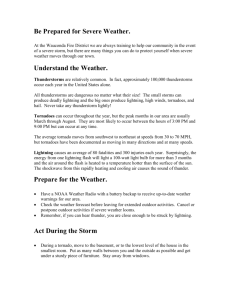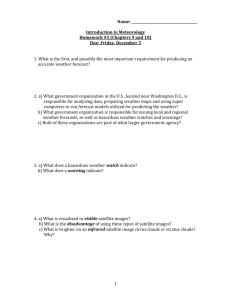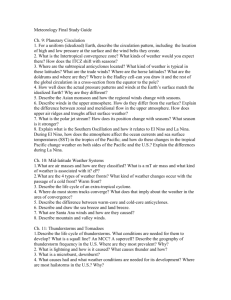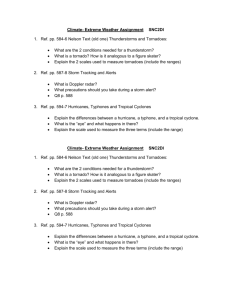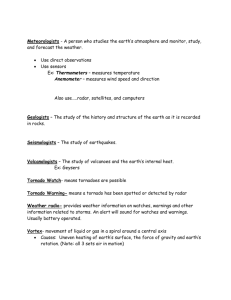Chapter 13 – The Nature of Storms
advertisement
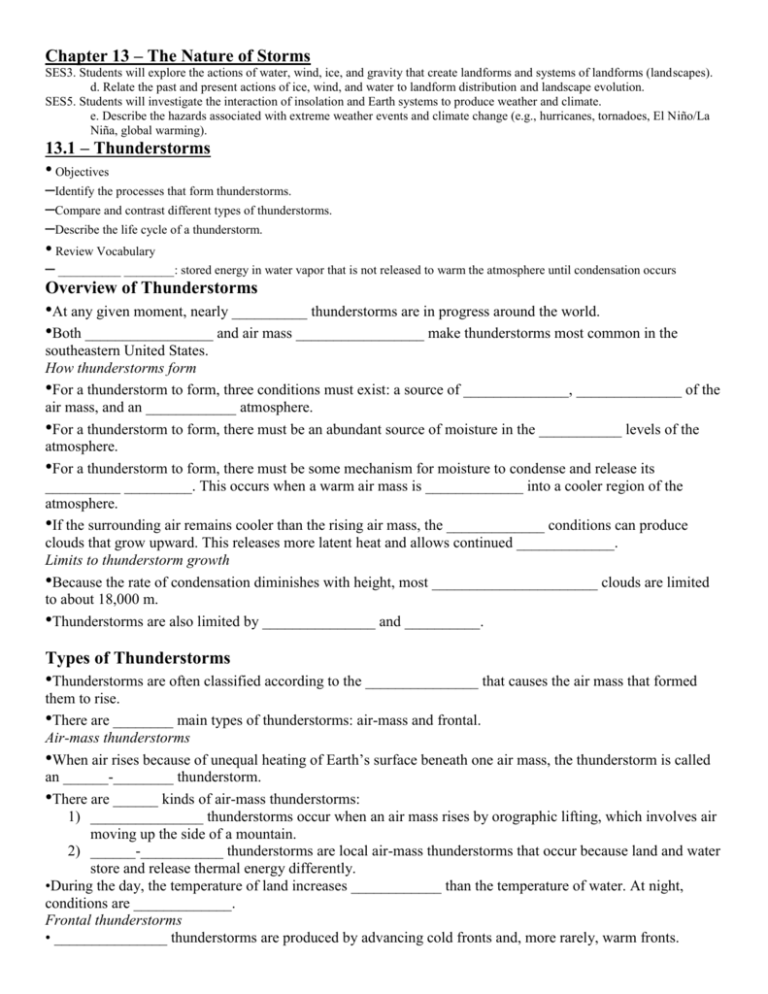
Chapter 13 – The Nature of Storms SES3. Students will explore the actions of water, wind, ice, and gravity that create landforms and systems of landforms (landscapes). d. Relate the past and present actions of ice, wind, and water to landform distribution and landscape evolution. SES5. Students will investigate the interaction of insolation and Earth systems to produce weather and climate. e. Describe the hazards associated with extreme weather events and climate change (e.g., hurricanes, tornadoes, El Niño/La Niña, global warming). 13.1 – Thunderstorms • Objectives –Identify the processes that form thunderstorms. –Compare and contrast different types of thunderstorms. –Describe the life cycle of a thunderstorm. • Review Vocabulary – __________ ________: stored energy in water vapor that is not released to warm the atmosphere until condensation occurs Overview of Thunderstorms •At any given moment, nearly __________ thunderstorms are in progress around the world. •Both _________________ and air mass _________________ make thunderstorms most common in the southeastern United States. How thunderstorms form •For a thunderstorm to form, three conditions must exist: a source of ______________, ______________ of the air mass, and an ____________ atmosphere. •For a thunderstorm to form, there must be an abundant source of moisture in the ___________ levels of the atmosphere. •For a thunderstorm to form, there must be some mechanism for moisture to condense and release its __________ _________. This occurs when a warm air mass is _____________ into a cooler region of the atmosphere. •If the surrounding air remains cooler than the rising air mass, the _____________ conditions can produce clouds that grow upward. This releases more latent heat and allows continued _____________. Limits to thunderstorm growth •Because the rate of condensation diminishes with height, most ______________________ clouds are limited to about 18,000 m. •Thunderstorms are also limited by _______________ and __________. Types of Thunderstorms •Thunderstorms are often classified according to the _______________ that causes the air mass that formed them to rise. •There are ________ main types of thunderstorms: air-mass and frontal. Air-mass thunderstorms •When air rises because of unequal heating of Earth’s surface beneath one air mass, the thunderstorm is called an ______-________ thunderstorm. •There are ______ kinds of air-mass thunderstorms: 1) _______________ thunderstorms occur when an air mass rises by orographic lifting, which involves air moving up the side of a mountain. 2) ______-___________ thunderstorms are local air-mass thunderstorms that occur because land and water store and release thermal energy differently. •During the day, the temperature of land increases ____________ than the temperature of water. At night, conditions are _____________. Frontal thunderstorms • _______________ thunderstorms are produced by advancing cold fronts and, more rarely, warm fronts. Thunderstorm Development •A thunderstorm usually has __________ stages: the cumulus stage, the mature stage, and the dissipation stage. The stages are classified according to the _______________ the air is moving. Cumulus stage • In the ______________ stage of a thunderstorm, air starts to rise _________________. This creates updrafts. Mature stage • In the ___________ stage, updrafts and downdrafts exist side by side in the cumulonimbus cloud. The updrafts and downdrafts form a _________________ cell which produces the surface winds associated with thunderstorms. Dissipation stage • In a thunderstorm, the cool downdrafts spread in all directions when they reach Earth’s surface. This cools the areas from which the storm draws its energy, the updrafts cease, and clouds can no longer form. The storm is then in the _________________ stage. Lightning • _____________ is the transfer of electrical charge caused by the rapid rushes of air in a cumulonimbus cloud. • ____________ between the updrafts and downdrafts within a cumulonimbus cloud removes electrons from some of the atoms in the cloud. Atoms that lose electrons become positively charged ions, and atoms that receive the extra electrons become negatively charged ions. • Eventually, the differences in charges break down, and a branched channel of partially charged air, called a ____________ ___________, is formed between the positive and negative regions. Thunder • A lightning bolt heats the surrounding air to about 30,000C, about _______ times hotter than the surface of the Sun. • The _____________ you hear is the sound produced as this superheated air rapidly expands and contracts. Lightning variations • There are several _________ given to lightning effects: sheet lightning, heat lightning, spider lightning, ball lightning, blue jets, and red sprites. Thunderstorm and lightning safety • Each _______ in the United States, lightning causes about 7500 forest fires and an average of 300 injuries and 93 deaths to humans. 13.1 – Summary •The cumulus stage, the mature stage, and the dissipation stage comprise the life _________ of a thunderstorm. •__________ form as water is condensed & latent heat is released. •Thunderstorms can be produced either within _____ _____________ or along ___________. •From formation to dissipation, all thunderstorms go through the same ___________. •________________ is a natural result of thunderstorm development. 13.1 – Review Questions Thunderstorms in the United States are most common in the Midwest. a. true b. false A mature thunderstorm has a region of updraft and a region of downdraft. a. true b. false What is the difference between air-mass thunderstorms and frontal thunderstorms? 13.2 Severe Weather SES3. Students will explore the actions of water, wind, ice, and gravity that create landforms and systems of landforms (landscapes). d. Relate the past and present actions of ice, wind, and water to landform distribution and landscape evolution. SES5. Students will investigate the interaction of insolation and Earth systems to produce weather and climate. e. Describe the hazards associated with extreme weather events and climate change (e.g., hurricanes, tornadoes, El Niño/La Niña, global warming). Objectives • Explain why some thunderstorms are more severe than others. • Recognize the dangers of severe weather, including lightning, hail, and high winds. • Describe how tornadoes form. Main Idea • All thunderstorms produce wind, rain, and lightning, which can have dangerous and damaging effects under certain circumstances. Review Vocabulary • ______ _______: large body of air that takes on the characteristics of the area over which it forms Weather Cells • • • All thunderstorms are ______ created equal. The increasing _______________ of the air intensifies the strength of a storm’s ____________ and _____________, which makes the storm severe. Supercells o Severe thunderstorms can develop into _______-______________, extremely powerful storms called ______________. o These furious storms can last for several ________ and can have ____________ as strong as 240 km/h (150 mph). o An anvil-shaped _______________ cloud is characteristic of many severe thunderstorms. Strong Winds • Violent ______________ that are concentrated in a local area are called _____________. • Based on the size of the _______ they affect, downbursts are classified as either ______________ or ______________. o Macroburts: path of destruction up to ____ km wide, wind speeds >______ km/h, last up to _____ mins. o Microbursts: path of destruction <____ km, winds >______ km/h, last <_____ mins. Hail • Hail is ______________ in the form of balls or lumps of ______. It forms because of ______ • • characteristics common to thunderstorms. For hail to form, water droplets rise to the heights of a _______________ cloud where the temperature is ________ freezing, encounter ice pellets, and _________ on contact with the pellets, which causes the ice pellets to grow _________. The second characteristic that allows hail to form is an abundance of strong ____________ and ______________ moving side by side within a cloud. Tornadoes • • • A tornado is a ___________, ___________ column of air in contact with the ground. Before a tornado reaches the _________, it is called a _________ cloud. Development of tornadoes o A tornado forms when wind ________ and ____________ change suddenly with __________, a phenomenon associated with wind shear. o Although tornadoes rarely exceed 200 m in diameter and usually last only a few minutes, they can be extremely _______________. • • • Tornado classification o The _________ tornado intensity scale, which ranks tornadoes according to their path of _______________, wind ________, and ___________, is used to classify tornadoes. Tornado distribution o Most tornadoes—especially violent ones—form in the spring during the late ____________ and __________, when the temperature contrasts between ________ air and ___________ air are the greatest. This type of large temperature contrast occurs most frequently in the central United States. o Many of the more than ______ tornadoes that touch down in the United States each year occur in a region called “__________ ________,” which extends from northern Texas through Oklahoma, Kansas, and Missouri. Tornado safety o If you are caught in a tornado, take shelter in the ____________ corner of a basement, a small downstairs room or closet, or a tornado shelter. 13.2 Section Summary • Intense rotating ___________ are associated with _____________. • _____________ are strong winds that result in damage associated with thunderstorms. • ________ is precipitation in the form of balls or lumps of ice that accompany severe storms. • The worst storm damage comes from a vortex of high winds that moves along the ground as a ___________. 13.2 Section Questions 1. The strongest thunderstorms develop under highly stable atmospheric conditions. a. true b. false 2. Which type of precipitation requires strong updrafts and downdrafts to exist side by side in a cloud? a. rain b. snow c. hail d. sleet 3. How do tornadoes form? Section 13.3 – Tropical Storms Real-World Link: If you try mixing cake batter in a shallow bowl, you might find that a low speed works well, but a high speed creates a big mess. ______________________________ form from processes similar to other storm systems, but their high winds can bring devastation to locations in their path. Main Idea Normally peaceful, _________________________ are capable of producing one of Earth’s most violent weather systems— ____________________________. Review Vocabulary __________________: caused by Earth’s rotation, moving particles, such as air, are deflected to the right north of the equator, and to the left south of the equator. Objectives Identify the conditions required for tropical cyclones to form. Describe the life cycle of a tropical cyclone. Recognize the dangers of hurricanes. Overview of Tropical Cyclones During summer and fall, the tropics experience conditions ideal for the formation of large, rotating, lowpressure tropical storms called________________________. Cyclone Location Favorable conditions for cyclone formation exist in all tropical oceans except the South _____________Ocean and the ________________ Ocean off the west coast of South America. Cyclone Formation Tropical cyclones require _______ basic conditions to form: an abundant supply of warm ocean ________ and some sort of mechanism to _________ warm air and keep it rising. The _____________indication of a building tropical cyclone is a moving tropical disturbance. When a ____________________ over a tropical ocean acquires a cyclonic circulation around a center of low pressure, it has reached the developmental stage and is known as a tropical ____________________. When wind speeds around the low-pressure center of a tropical depression exceed ______ km/h, the system is called a tropical _______________. If air pressure continues to fall and winds around the center reach at least ________ km/h, the storm is officially classified as a ______________. Once winds reach at least _______ km/h, another phenomenon occurs—the development of a calm center of the storm called the ________. The eye of the cyclone is a span of 30 to ______ km of ________ weather and blue sky. The ______________ winds in a hurricane are usually concentrated in the _______________—a tall band of strong winds and dense clouds that surrounds the eye. A hurricane will last until it can no longer produce enough _____________ to sustain itself. This usually happens when the storm has moved either over ___________ or over _________________________. Tropical Cyclone Movement Like all large-scale storms, tropical cyclones move according to the __________________ that steer them. Hurricane Hazards The __________________________hurricane scale classifies hurricanes according to _______________, potential for ________________ due to the effect on the height of sea level, and potential for property ____________________. Damage Hurricanes can cause extensive damage, particularly along _____________ areas, which tend to be where human populations are the most ____________. Winds Much of the damage caused by hurricanes is associated with _________________________. Storm Surge A ______________________ occurs when hurricane-force winds drive a mound of ocean water toward coastal areas where it washes over the land. Hurricane Advisories and Safety The __________________________________________ issues a hurricane warning at least ________ hours before a hurricane is predicted to strike. ____________________, combined with proper safety _______________________, has greatly reduced death tolls associated with hurricanes in recent years. 13.3 Summary Cyclones rotate ______________________________ in the northern hemisphere. Cyclones are also known as _________________ & _____________________. Cyclones go through the same stages of __________________ & ____________________ as other storms. Cyclones are moved by various _____________ systems after they form. The most dangerous part of a tropical cyclone is the _______________________. Hurricane _________________ are given at least _________ hours before the hurricane arrives. 13.3 Review Questions 1. At what latitudes do tropical cyclones usually form? a. between 0 and 5 degrees b. between 5 and 30 degrees c. between 30 and 50 degrees d. between 50 and 70 degrees 2. What weather condition usually exists within the eye of a hurricane? a. high wind b. calm wind c. tornadoes d. lightning 3. What is the source of a hurricane’s energy? Answer: Comes from the _______________________ over which it develops. As ocean water ______________, some heat is taken from the ocean. The water vapor then rises high into the ___________________. The heat that was taken from the ocean is released to the atmosphere as the water vapor ________________.
